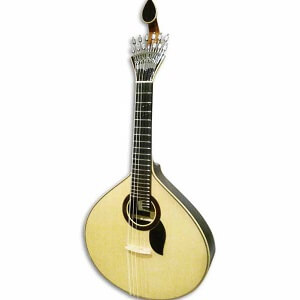Guitarra Portuguesa
 Portuguese guitar, a 12-string cousin of the modern instrument. The fact is that the Portuguese guitar is a traditional Portuguese stringed instrument identifiable anywhere in the world for its unmistakable sound. Since the beginning it is a great instrument for concerts with its own repertoire, despite being the main instrument accompanying fado, to which it was definitively added in the second half of the nineteenth century. It is a handmade instrument built with wood and fine materials, it´s main features are: the 12 steel strings arranged in 6 pairs or orders, the mobile bridge made of bone, the round resonance-box, the little arm with ornamented volute and fan-shaped machine heads, the inlaid nacre or the ornaments on the wood itself.
Portuguese guitar, a 12-string cousin of the modern instrument. The fact is that the Portuguese guitar is a traditional Portuguese stringed instrument identifiable anywhere in the world for its unmistakable sound. Since the beginning it is a great instrument for concerts with its own repertoire, despite being the main instrument accompanying fado, to which it was definitively added in the second half of the nineteenth century. It is a handmade instrument built with wood and fine materials, it´s main features are: the 12 steel strings arranged in 6 pairs or orders, the mobile bridge made of bone, the round resonance-box, the little arm with ornamented volute and fan-shaped machine heads, the inlaid nacre or the ornaments on the wood itself.
Regarding construction, the two most used variants are the Lisbon and Coimbra guitar. Visually it is easy to distinguish the different volutes; Lisbon’s guitar has the form of a snail while Coimbra has a teardrop shape. The body and neck dimensions of the Coimbra guitar are slightly larger, giving it a fuller sound with more volume and less treble. The tunings are also different, the tuning of the Lisbon guitar is (B, A, E, B, A, D) from the high note to the lower, while its counterpart of Coimbra tunes one note down (A, G, D, A, G, C).